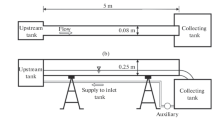Abstract
Broad-crested weirs are defined as structures where the streamlines are parallel to each other and the pressure is hydrostatic over the horizontal crest. The water surface profile for submerged flow over weir was estimated through flume experimentation and compared with numerical model results. The numerical model was developed using ANSYS FLUENT version 15 in three dimensions (3D) with a standard k–ε turbulent model. The Volume of Fluid (VOF) method was used to estimate the water level in each cell and includes tail water influence acting on a broad-crested weir. The agreement between the FLUENT model and the experimental results for water depth was good. Such conditions are often difficult to predict, particularly at onset of the hydraulic jump. The numerically derived pressure and velocity distributions over the weir are simulated in 3D. Good agreement was achieved between numerical and experimental discharge with a relative error of 6.6%. The relative error between the numerical and experimental coefficient of discharge was 7.7%.












Similar content being viewed by others
References
ANSYS Fluent 15.0 User‘s Guide. November 28 (2011)
M.G. Bos, “Discharge measurement structures”, International Institute for Land Reclamation and Improvement (ILRI) Publication 20, Wageningen, The Netherlands (1989)
H. Cui, Non-hydrostatic numerical modeling of hydraulic jump over a weir. Master Thesis, Delft University of Technology (2007)
W.H. Hager, M. Schwalt, Broad-crested weir. J. Irrig. Drain. Eng. 120(1), 13–26 (1994)
C.W. Hirt, B.D. Nichols, Volume of fluid (VOF) method for the dynamics of free boundaries. J. Comput. Phys. 39(1), 201–225 (1981)
L. Qingchao, V. Drewes, Turbulence characteristics in free and forced hydraulic jumps. J. Hydraul. Res. 32, 877–898 (1994)
F. Ma, Y. Hou, P. Prinos, Numerical calculation of submerged hydraulic jumps. J. Hydraul. Res. 3, 493–503 (2001)
F. Rostami, M. Shahrokhi, M.A. Md Saod, S.R. Sabbagh Yazdi, Numerical simulation of undular hydraulic jump on smooth bed using volume of fluid method. Appl. Math. Model. 37, 1514–1522 (2013)
M.A. Sarker, D.G. Rhodes, Calculation of free surface profile over a rectangular broad-crested weir. Flow Meas. Instrum. 15(4), 215–219 (2004)
F.M. Sauida, Prediction of hydraulic jump length downstream of multi-vent regulators using Artificial Neural Networks. Ain Shams Eng. J. 7, 819–826 (2016)
Acknowledgements
The authors would like to pay a thank to the respectable Mustansiriyah University, Baghdad, Iraq (www.uomustansiriyah.edu.iq), where the experiments works were carried out at the laboratories of the hydrology and hydraulic for the Faculty of Engineering at University.
Author information
Authors and Affiliations
Corresponding author
Additional information
Publisher's Note
Springer Nature remains neutral with regard to jurisdictional claims in published maps and institutional affiliations.
Rights and permissions
About this article
Cite this article
Al-Hashimi, S.A.M., Saeed, K.A. & Nahi, T.N. Experimental and CFD Modeling of Hydraulic Jumps Forming at Submerged Weir. J. Inst. Eng. India Ser. A 100, 487–493 (2019). https://doi.org/10.1007/s40030-019-00381-z
Received:
Accepted:
Published:
Issue Date:
DOI: https://doi.org/10.1007/s40030-019-00381-z




